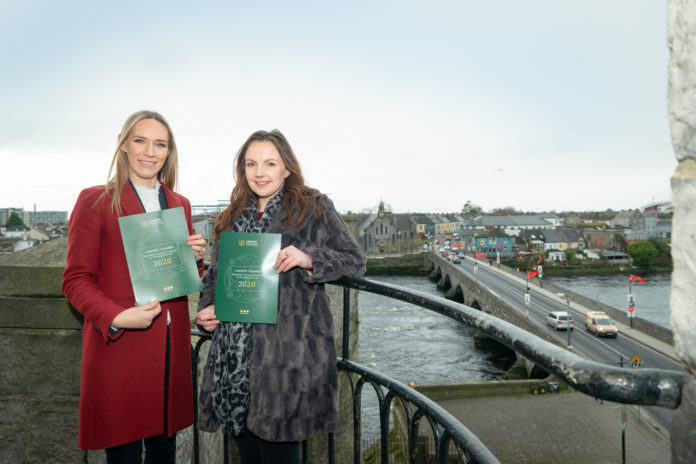AN economic overview of the Mid-West by Limerick Chamber has found tourism in the region could lose up to €500m, while unemployment is still running at almost three times pre COVID-19 levels.
Limerick Chamber’s ‘Mid-West Economic Insights’, compiled by its Chief Economist Dr Catríona Cahill, has looked at various economic indicators from 2019 and across the first six months of 2020. The report paints a stark assessment of the challenges facing the region and highlights the most fragile elements of the local economy.
Headline findings include that unemployment shot from 4.9% prior to COVD-19 to 32% during lockdown, with latest figures showing it has reduced to approximately 14.5%.
The report warns of the need for the region to brace itself for the impact of significant visitor and tourism related revenue decline. Using regional data from Failte Ireland, Limerick Chamber has estimated that the Mid-West had losses of up to €174 million for the second quarter of 2020 alone.
Dr. Cahill warned the Mid West is particularly exposed to the adverse impact of COVID-19 on tourism with anticipated annualised losses feared to be between €372 and €496 million euro, though the summer staycation months will have accounted for a partial recovery, she stated in the report.
Meanwhile, the report finds that the number of Foreign Direct Investment jobs in IDA supported companies in the region now accounts for 11.4%, up from 9.5% in 2012. Furthermore, Limerick ranks second nationally for county level FDI associated employment at 25.3%, only surpassed by Dublin at 29.1%.
This endorsement of the value proposition for inward investment is welcome news. However, threats posed to Shannon Airport’s connectivity brought about by the onset of the pandemic, and the airports significance in terms of FDI were also highlighted as a vulnerability to the wider economy.
“The impact of COVID-19 on the operations of Shannon Airport is of significant concern as the airport contributes €3.6 billion to the economy and supports 45,595 jobs,” Dr Cahill states.
In the commercial property sector it is a story of two halves; the report highlights that commercial office construction in Limerick in the first half of the year lagged significantly behind that of Cork and Galway, a fact that reflects the slower recovery in that market in Limerick since the last recession by comparison to the other cities.
Using a metric that classifies commercial site development as ‘under construction’ once ground works have been completed on site and building is underway, Limerick registered zero square meters of commercial property under construction for Q1 and Q2 versus 23,650sq m for Galway and 38,500sq m for Cork.
Dr. Cahill added: “We are aware of a number of developments that commenced groundworks recently and so we do expect to see this number significantly increase in the second half of the year and early 2021 as progress on those projects continues.”
In contrast to the lag in commercial office construction activity, development within the commercial industrial market in Limerick (with 44,750 sq m under construction) is ahead of both Cork and Galway, with 11,650 sq m and 3,250 sq m respectively.
With prime commercial space renting for €250 sq m – less than half Dublin’s rate of €673 sq m and less also than Galway (€323 sq m) and Cork (€325 sq m) – Limerick Chamber’s report revealed that Limerick offered greater value when compared to the other main cities.
However, the report notes that GeoDirectory recently reported an increase in Limerick’s commercial vacancy rates in Q2, with Limerick having the second highest of the four main cities at 15.9%, behind Galway at 16.6% and ahead of Dublin at 12.2% and Cork at 11.9%.
“COVID-19 is placing significant pressure on retail and hospitality sectors with a number of notable business closures already announced in the city. A vacant site strategy will be urgently needed to tackle the scarring on the city centre and the negative impact this has on revitalisation efforts” she said.
The Economic Insights report also reveals that growth in house prices in the Mid West has slowed with property prices increasing by just 0.7% in the year to June 2020, compared to 3.7% in the previous 12 months.
The highest median prices in the Mid-West for the January to July period were for new houses in Limerick city (€346,666) purchased by former owner occupiers. In terms of existing houses, Limerick county held the highest median value at €205,166.
There was good news for renters as Limerick experienced the lowest annual increase in rent across the five cities. Of the country’s five largest cities, Limerick has the 2nd lowest average rent (€925) against Dublin (€1,702), Cork (€1,199), Galway (€1,156) and Waterford (€814) in Q1 2020.
Housing completions rose year-on-year throughout the period indicating an increase in housing supply. But the report notes that between 2018 and 2019, apartment completions increased in both Clare and Tipperary whereas they fell in Limerick.
Commenting on the key findings of the report Dr. Cahill said, “The data paints an honest but stark picture of the impact of COVID-19 to the Mid-West in addition to the underlying economic challenges that were already present.
Within the challenges there are opportunities – notably the mass adoption of remote working practices by organisations and the comparatively low cost of residential housing in the Mid-West.
“However, in order to capitalise on any opportunities and to ensure a balanced recovery it is imperative that the Government recognises the regional differences in the impact of the crisis and move to ensure that existing regional imbalances are not worsened as a result of the pandemic.”







